Analysis of Driving Factors of Cropland Productivity in Northeast China Using OPGD-SHAP Framework
Abstract
1. Introduction
2. Materials and Methods
2.1. Study Area
2.2. Data Source
2.2.1. Cropland Productivity
2.2.2. Explanatory Variables
2.3. Methods
2.3.1. Optimal Parameter-Based Geographical Detector
2.3.2. SHapley Additive exPlanations
3. Results
3.1. Spatiotemporal Variations of Cropland Productivity
3.2. Spatial Contributions of Driving Factors for Cropland Productivity
3.2.1. Effects of Single Driving Factors
3.2.2. Interactive Effects Among Driving Factors
3.3. SHAP Explanations of the Driving Mechanisms
3.3.1. Comparative Assessment of Machine Learning Models
3.3.2. Identification of the Key Drivers of Cropland Productivity
3.3.3. Interactions Between the Key Drivers of Cropland Productivity
4. Discussion
4.1. Importance, Mechanisms, and Thresholds of the Multidimensional Drivers for Cropland Productivity
4.2. Policy Implications
4.3. Advantages and Limitations
5. Conclusions
Author Contributions
Funding
Data Availability Statement
Conflicts of Interest
Abbreviations
| GD | Geographical detector |
| OPGD | Optimal parameter-based geographical detector |
| SHAP | SHapley Additive exPlanations |
| NPP | Net Primary Productivity |
| CASA | Carnegie-Ames-Stanford Approach |
| ACP | Average cropland productivity |
| TCP | Total cropland productivity |
| PRE | Precipitation |
| TEM | Temperature |
| SOL | Solar radiation |
| ELV | Elevation |
| SLP | Slope |
| ERS | Erosion |
| IRR | Effective irrigation |
| FER | Fertilizer application |
| MAC | Machinery |
| ELC | Electricity |
Appendix A
| Variable | ACP | TCP | ||
|---|---|---|---|---|
| Method | Number | Method | Number | |
| PRE | Natural | 7 | Equal | 9 |
| TEM | Standard deviation | 9 | Standard deviation | 9 |
| MAC | Geometric | 9 | Geometric | 9 |
| IRR | Natural | 9 | Quantile | 8 |
| FER | Natural | 9 | Natural | 9 |
| ELE | Quantile | 9 | Quantile | 9 |
| ERS | Natural | 9 | Quantile | 9 |
| SOL | Natural | 9 | Natural | 9 |
| ALT | Quantile | 7 | Quantile | 9 |
| SLP | Quantile | 9 | Quantile | 8 |
| Model | Hyperparameter | Description | Search Range | Best Value | |
|---|---|---|---|---|---|
| ACP | TCP | ||||
| CatBoost | depth | Maximum tree depth | [3, 5, 7] | 5 | 3 |
| iterations | Number of boosting iterations | [100, 200, 300] | 300 | 300 | |
| l2_left_reg | L2 regularization coefficient | [1, 3, 5] | 1 | 3 | |
| learning_rate | Step size shrinkage for boosting | [0.01, 0.1, 0.2] | 0.2 | 0.2 | |
| XGBoost | colsample_bytree | Fraction of features sampled for each tree | [100, 200, 300] | 0.8 | 1 |
| learning_rate | Step size shrinkage for boosting | [0.01, 0.1, 0.2] | 0.1 | 0.2 | |
| max_depth | Maximum tree depth | [3, 5, 7] | 5 | 3 | |
| n_estimator | Number of boosting trees | [0.6, 0.8, 1.0] | 300 | 300 | |
| subsample | Fraction of features sampled for each tree | [0.6, 0.8, 1.0] | 0.6 | 1 | |
| LightGBM | colsample_bytree | Fraction of features sampled for each tree | [100, 200, 300] | 0.6 | 1 |
| learning_rate | Step size shrinkage for boosting | [0.01, 0.1, 0.2] | 0.2 | 0.2 | |
| max_depth | Maximum tree depth | [3, 5, 7] | 3 | 3 | |
| n_estimator | Number of boosting trees | [0.6, 0.8, 1.0] | 300 | 300 | |
| subsample | Fraction of features sampled for each tree | [0.6, 0.8, 1.0] | 0.6 | 0.6 | |
| Random Forest | max_depth | Maximum tree depth | [100, 200, 300] [3, 5, 7] | None | None |
| n_estimator | Number of trees in the forest | [None, 3, 5, 7] | 300 | 100 | |
| Support Vector Machine | C | Regularization parameter | [0.1, 1, 10] | 10 | 10 |
| epsilon | Epsilon parameter in epsilon-SVR | [0.01, 0.1, 1] | 0.1 | 0.1 | |
| kernel | Kernel function type | [rbf, linear, poly] | rbf | rbf | |

References
- Shi, W.; Wang, M.; Liu, Y. Crop Yield and Production Responses to Climate Disasters in China. Sci. Total Environ. 2021, 750, 141147. [Google Scholar] [CrossRef] [PubMed]
- Yan, H.; Du, W.; Zhou, Y.; Luo, L.; Niu, Z. Satellite-Based Evidences to Improve Cropland Productivity on the High-Standard Farmland Project Regions in Henan Province, China. Remote Sens. 2022, 14, 1724. [Google Scholar] [CrossRef]
- Han, B.; Jin, X.; Yeting, F.; Chen, H.; Jin, J.; Xu, W.; Ren, J.; Zhou, Y. Trend and Spatial Pattern of Stable Cropland Productivity in China Based on Satellite Observations (2001–2020). Environ. Impact Assess. Rev. 2023, 101, 107136. [Google Scholar] [CrossRef]
- Liu, Y.; Sun, D.; Wang, H.; Wang, X.; Yu, G.; Zhao, X. An Evaluation of China’s Agricultural Green Production: 1978–2017. J. Clean. Prod. 2020, 243, 118483. [Google Scholar] [CrossRef]
- National Bureau of Statistics of China. China Statistical Yearbook; China Statistics Press: Beijing, China, 2024. [Google Scholar]
- Xu, X.Z.; Xu, Y.; Chen, S.C.; Xu, S.G.; Zhang, H.W. Soil Loss and Conservation in the Black Soil Region of Northeast China: A Retrospective Study. Environ. Sci. Policy 2010, 13, 793–800. [Google Scholar] [CrossRef]
- Duan, X.; Xie, Y.; Ou, T.; Lu, H. Effects of Soil Erosion on Long-Term Soil Productivity in the Black Soil Region of Northeastern China. CATENA 2011, 87, 268–275. [Google Scholar] [CrossRef]
- Liu, Z.; Wang, M.; Liu, X.; Wang, F.; Li, X.; Wang, J.; Hou, G.; Zhao, S. Ecological Security Assessment and Warning of Cultivated Land Quality in the Black Soil Region of Northeast China. Land 2023, 12, 1005. [Google Scholar] [CrossRef]
- Yang, X.; Lin, E.; Ma, S.; Ju, H.; Guo, L.; Xiong, W.; Li, Y.; Xu, Y. Adaptation of Agriculture to Warming in Northeast China. Clim. Change 2007, 84, 45–58. [Google Scholar] [CrossRef]
- Xu, Q.; Liang, H.; Wei, Z.; Zhang, Y.; Lu, X.; Li, F.; Wei, N.; Zhang, S.; Yuan, H.; Liu, S.; et al. Assessing Climate Change Impacts on Crop Yields and Exploring Adaptation Strategies in Northeast China. Earths Future 2024, 12, e2023EF004063. [Google Scholar] [CrossRef]
- Mechiche-Alami, A.; Abdi, A.M. Agricultural Productivity in Relation to Climate and Cropland Management in West Africa. Sci. Rep. 2020, 10, 3393. [Google Scholar] [CrossRef]
- Ray, D.K.; Gerber, J.S.; MacDonald, G.K.; West, P.C. Climate Variation Explains a Third of Global Crop Yield Variability. Nat. Commun. 2015, 6, 5989. [Google Scholar] [CrossRef] [PubMed]
- Raseduzzaman, M.; Jensen, E.S. Does Intercropping Enhance Yield Stability in Arable Crop Production? A Meta-Analysis. Eur. J. Agron. 2017, 91, 25–33. [Google Scholar] [CrossRef]
- Li, T.; Long, H.; Zhang, Y.; Tu, S.; Ge, D.; Li, Y.; Hu, B. Analysis of the Spatial Mismatch of Grain Production and Farmland Resources in China Based on the Potential Crop Rotation System. Land Use Policy 2017, 60, 26–36. [Google Scholar] [CrossRef]
- Shah, F.; Wu, W. Soil and Crop Management Strategies to Ensure Higher Crop Productivity within Sustainable Environments. Sustainability 2019, 11, 1485. [Google Scholar] [CrossRef]
- Egli, L.; Schröter, M.; Scherber, C.; Tscharntke, T.; Seppelt, R. Crop Diversity Effects on Temporal Agricultural Production Stability across European Regions. Reg. Environ. Change 2021, 21, 96. [Google Scholar] [CrossRef]
- Zymaroieva, A.; Zhukov, O.; Fedoniuk, T.; Pinkina, T.; Hurelia, V. The Relationship Between Landscape Diversity and Crops Productivity: Landscape Scale Study. J. Landsc. Ecol. 2021, 14, 39–58. [Google Scholar] [CrossRef]
- Penghui, J.; Manchun, L.; Liang, C. Dynamic Response of Agricultural Productivity to Landscape Structure Changes and Its Policy Implications of Chinese Farmland Conservation. Resour. Conserv. Recycl. 2020, 156, 104724. [Google Scholar] [CrossRef]
- Nguyen, L.H.; Robinson, S.V.J.; Galpern, P. Effects of Landscape Complexity on Crop Productivity: An Assessment from Space. Agric. Ecosyst. Environ. 2022, 328, 107849. [Google Scholar] [CrossRef]
- Lichtenberg, E.; Ding, C. Assessing Farmland Protection Policy in China. Land Use Policy 2008, 25, 59–68. [Google Scholar] [CrossRef]
- Liu, Q.; Xu, H.; Yi, H. Impact of Fertilizer on Crop Yield and C:N:P Stoichiometry in Arid and Semi-Arid Soil. Int. J. Environ. Res. Public Health 2021, 18, 4341. [Google Scholar] [CrossRef]
- Li, T.; Li, L.; Chen, X.; Zhang, S.; Wang, H.; Pu, Y.; Xu, X.; Wang, G.; Jia, Y.; Li, H.; et al. Soil Quality Assessment of Cropland in China and Its Relationships with Climate and Topography. Land Degrad. Dev. 2023, 34, 637–652. [Google Scholar] [CrossRef]
- Long, Y.; Zeng, Y.; Liu, X.; Yang, Y. Multivariate Analysis of Grain Yield and Main Agronomic Traits in Different Maize Hybrids Grown in Mountainous Areas. Agriculture 2024, 14, 1703. [Google Scholar] [CrossRef]
- Dong, H.; Han, J.; Zhang, Y.; Chen, T.; Fan, H.; Wang, C. Research on Influencing Factors of Cultivated Land Productivity of High-Standard Farmland Projects in Hanzhong City of China—An Empirical Study Based on PLS-SEM. Front. Sustain. Food Syst. 2023, 7, 1176426. [Google Scholar] [CrossRef]
- Zhang, J.; Zhang, Y.; Qin, Y.; Lu, X.; Cao, J. The Spatiotemporal Pattern of Grassland NPP in Inner Mongolia Was More Sensitive to Moisture and Human Activities than That in the Qinghai-Tibetan Plateau. Glob. Ecol. Conserv. 2023, 48, e02709. [Google Scholar] [CrossRef]
- He, Y.; Lin, C.; Wu, C.; Pu, N.; Zhang, X. The Urban Hierarchy and Agglomeration Effects Influence the Response of NPP to Climate Change and Human Activities. Glob. Ecol. Conserv. 2024, 51, e02904. [Google Scholar] [CrossRef]
- Guo, X.; Yuan, L.; Chen, X. Spatial-Temporal Variations and Influencing Factors of Vegetation Net Primary Productivity: A Case Study of Yunnan Province, China. Pol. J. Environ. Stud. 2025, 34, 2141–2156. [Google Scholar] [CrossRef]
- Wang, C.; Wang, L.; Zhao, W.; Zhang, Y.; Liu, Y. Analysis of Spatiotemporal Change and Driving Factors of NPP in Qilian Mountains From 2000 to 2020. Rangel. Ecol. Manag. 2024, 96, 56–66. [Google Scholar] [CrossRef]
- Long, B.; Zeng, C.; Zhou, T.; Yang, Z.; Rao, F.; Li, J.; Chen, G.; Tang, X. Quantifying the Relative Importance of Influencing Factors on NPP in Hengduan Mountains of the Tibetan Plateau from 2002 to 2021: A Dominance Analysis. Ecol. Inform. 2024, 81, 102636. [Google Scholar] [CrossRef]
- Zhang, H.; Xu, Y.; Lu, Y.; Hasi, E.; Zhang, H.; Zhang, S.; Wang, W. Spatiotemporal Variations and Driving Factors of Crop Productivity in China from 2001 to 2020. J. Environ. Manag. 2024, 371, 123344. [Google Scholar] [CrossRef]
- Yi, Z.; Wu, L. Identification of Factors Influencing Net Primary Productivity of Terrestrial Ecosystems Based on Interpretable Machine Learning—Evidence from the County-Level Administrative Districts in China. J. Environ. Manag. 2023, 326, 116798. [Google Scholar] [CrossRef]
- Ba, W.; Qiu, H.; Cao, Y.; Gong, A. Spatiotemporal Characteristics Prediction and Driving Factors Analysis of NPP in Shanxi Province Covering the Period 2001–2020. Sustainability 2023, 15, 12070. [Google Scholar] [CrossRef]
- Li, T.; Zhang, Q.; Peng, Y.; Guan, X.; Li, L.; Mu, J.; Wang, X.; Yin, X.; Wang, Q. Contributions of Various Driving Factors to Air Pollution Events: Interpretability Analysis from Machine Learning Perspective. Environ. Int. 2023, 173, 107861. [Google Scholar] [CrossRef] [PubMed]
- Meng, X.; Li, S.; Akhmadi, K.; He, P.; Dong, G. Trends, Turning Points, and Driving Forces of Desertification in Global Arid Land Based on the Segmental Trend Method and SHAP Model. GIScience Remote Sens. 2024, 61, 2367806. [Google Scholar] [CrossRef]
- Yang, L.; Ji, X.; Li, M.; Yang, P.; Jiang, W.; Chen, L.; Yang, C.; Sun, C.; Li, Y. A Comprehensive Framework for Assessing the Spatial Drivers of Flood Disasters Using an Optimal Parameter-Based Geographical Detector–Machine Learning Coupled Model. Geosci. Front. 2024, 15, 101889. [Google Scholar] [CrossRef]
- Cassidy, E.S.; West, P.C.; Gerber, J.S.; Foley, J.A. Redefining Agricultural Yields: From Tonnes to People Nourished per Hectare. Environ. Res. Lett. 2013, 8, 034015. [Google Scholar] [CrossRef]
- Yu, D.; Shi, P.; Shao, H.; Zhu, W.; Pan, Y. Modelling Net Primary Productivity of Terrestrial Ecosystems in East Asia Based on an Improved CASA Ecosystem Model. Int. J. Remote Sens. 2009, 30, 4851–4866. [Google Scholar] [CrossRef]
- Xu, F.; Wang, X.; Li, L. NPP and Vegetation Carbon Sink Capacity Estimation of Urban Green Space Using the Optimized CASA Model: A Case Study of Five Chinese Cities. Atmosphere 2023, 14, 1161. [Google Scholar] [CrossRef]
- Zhang, J.; Wang, J.; Chen, Y.; Huang, S.; Liang, B. Spatiotemporal Variation and Prediction of NPP in Beijing-Tianjin-Hebei Region by Coupling PLUS and CASA Models. Ecol. Inform. 2024, 81, 102620. [Google Scholar] [CrossRef]
- Xu, X.; Liu, J.; Zhang, S.; Li, R.; Yan, C.; Wu, S. China’s Multi-Period Land Use Land Cover Remote Sensing Monitoring Data Set (CNLUCC); Resource and Environment Data Cloud Platform: Beijing, China, 2018. [Google Scholar]
- Zhu, W.-Q.; Pan, Y.-Z.; Zhang, J.-S. Estimation of Net Primary Productivity of Chinese Terrestrial Vegetation Based on Remote Sensing. Chin. J. Plant Ecol. 2007, 31, 413. [Google Scholar]
- Dong, M.; Jiang, Y.; Zhang, D.; Wu, Z. Spatiotemporal Change in the Climatic Growing Season in Northeast China during 1960–2009. Theor. Appl. Climatol. 2013, 111, 693–701. [Google Scholar] [CrossRef]
- Renard, D.; Tilman, D. National Food Production Stabilized by Crop Diversity. Nature 2019, 571, 257–260. [Google Scholar] [CrossRef] [PubMed]
- Egli, L.; Schröter, M.; Scherber, C.; Tscharntke, T.; Seppelt, R. Crop Asynchrony Stabilizes Food Production. Nature 2020, 588, E7–E12. [Google Scholar] [CrossRef] [PubMed]
- Wang, S.; Xu, X.; Huang, L. Spatial and Temporal Variability of Soil Erosion in Northeast China from 2000 to 2020. Remote Sens. 2023, 15, 225. [Google Scholar] [CrossRef]
- Liu, Y.; Huang, C.; Yang, C.; Chen, C. Spatiotemporal Variation and Driving Factors of Vegetation Net Primary Productivity in the Guanzhong Plain Urban Agglomeration, China from 2001 to 2020. J. Arid Land 2025, 17, 74–92. [Google Scholar] [CrossRef]
- He, H.; Ding, R.; Tian, X. Spatiotemporal Characteristics and Influencing Factors of Grain Yield at the County Level in Shandong Province, China. Sci. Rep. 2022, 12, 12001. [Google Scholar] [CrossRef]
- Sang, X.; Chen, C.; Hu, D.; Rahut, D.B. Economic Benefits of Climate-Smart Agricultural Practices: Empirical Investigations and Policy Implications. Mitig. Adapt. Strateg. Glob. Change 2024, 29, 9. [Google Scholar] [CrossRef]
- Wang, J.; Xu, D. Geodetector: Principle and prospect. Acta Geogr. Sin. 2017, 72, 116–134. [Google Scholar] [CrossRef]
- Song, Y.; Wang, J.; Ge, Y.; Xu, C. An Optimal Parameters-Based Geographical Detector Model Enhances Geographic Characteristics of Explanatory Variables for Spatial Heterogeneity Analysis: Cases with Different Types of Spatial Data. GIScience Remote Sens. 2020, 57, 593–610. [Google Scholar] [CrossRef]
- Song, Y.; Wu, P. An Interactive Detector for Spatial Associations. Int. J. Geogr. Inf. Sci. 2021, 35, 1676–1701. [Google Scholar] [CrossRef]
- Chen, H.; Covert, I.C.; Lundberg, S.M.; Lee, S.-I. Algorithms to Estimate Shapley Value Feature Attributions. Nat. Mach. Intell. 2023, 5, 590–601. [Google Scholar] [CrossRef]
- Lundberg, S.; Lee, S.-I. A Unified Approach to Interpreting Model Predictions. In Proceedings of the Advances in Neural Information Processing Systems, Long Beach, CA, USA, 4–9 December 2017. [Google Scholar]
- Kuhn, M.; Johnson, K. Applied Predictive Modeling; Springer: New York, NY, USA, 2013; ISBN 978-1-4614-6848-6. [Google Scholar]
- Duan, D.; Wang, P.; Rao, X.; Zhong, J.; Xiao, M.; Huang, F.; Xiao, R. Identifying Interactive Effects of Spatial Drivers in Soil Heavy Metal Pollutants Using Interpretable Machine Learning Models. Sci. Total Environ. 2024, 934, 173284. [Google Scholar] [CrossRef] [PubMed]
- Xiao, J.; Zhou, Y.; Zhang, L. Contributions of Natural and Human Factors to Increases in Vegetation Productivity in China. Ecosphere 2015, 6, art233. [Google Scholar] [CrossRef]
- Yan, Y.; Xu, X.; Liu, X.; Wen, Y.; Ou, J. Assessing the Contributions of Climate Change and Human Activities to Cropland Productivity by Means of Remote Sensing. Int. J. Remote Sens. 2020, 41, 2004–2021. [Google Scholar] [CrossRef]
- Sun, F.; Chen, B.; Xiao, J.; Li, F.; Sun, J.; Wang, Y. Effects of Natural Factors and Human Activities on the Spatio-Temporal Distribution of Net Primary Productivity in an Inland River Basin. Land 2025, 14, 650. [Google Scholar] [CrossRef]
- Li, Y.; Yang, X.; Cai, H.; Xiao, L.; Xu, X.; Liu, L. Topographical Characteristics of Agricultural Potential Productivity during Cropland Transformation in China. Sustainability 2015, 7, 96–110. [Google Scholar] [CrossRef]
- Niedertscheider, M.; Kastner, T.; Fetzel, T.; Haberl, H.; Kroisleitner, C.; Plutzar, C.; Erb, K.-H. Mapping and Analysing Cropland Use Intensity from a NPP Perspective. Environ. Res. Lett. 2016, 11, 014008. [Google Scholar] [CrossRef]
- Yan, Y.; Liu, X.; Wen, Y. Quantification of the Relationship Among Cropland Area, Cropland Management Measures, and Cropland Productivity Using Panel Data Model. Int. J. Plant Prod. 2020, 14, 689–702. [Google Scholar] [CrossRef]
- Zheng, Z.; Song, H. Improving the Benefit Compensation Mechanism for Main Grain Producing Areas: Basis, Problems, and Policy Optimization. Res. Agric. Mod. 2023, 44, 214–221. [Google Scholar] [CrossRef]
- Zeng, X.; Hu, Z.; Chen, A.; Yuan, W.; Hou, G.; Han, D.; Liang, M.; Di, K.; Cao, R.; Luo, D. The Global Decline in the Sensitivity of Vegetation Productivity to Precipitation from 2001 to 2018. Glob. Change Biol. 2022, 28, 6823–6833. [Google Scholar] [CrossRef]
- Alexander, J.D.; McCafferty, M.K.; Fricker, G.A.; James, J.J. Climate Seasonality and Extremes Influence Net Primary Productivity across California’s Grasslands, Shrublands, and Woodlands. Environ. Res. Lett. 2023, 18, 064021. [Google Scholar] [CrossRef]
- Zhe, Y.; Denghua, Y.; Zhiyong, Y.; Jun, Y.I.N.; Yong, Y. Research on temporal and spatial change of 400 mm and 800 mm rainfall contours of China in 1961–2000. Adv. Water Sci. 2014, 25, 494–502. [Google Scholar]
- Liu, J.; Bi, X.; Ma, M.; Jiang, L.; Du, L.; Li, S.; Sun, Q.; Zou, G.; Liu, H. Precipitation and Irrigation Dominate Soil Water Leaching in Cropland in Northern China. Agric. Water Manag. 2019, 211, 165–171. [Google Scholar] [CrossRef]
- Fu, J.; Wang, W.; Zaitchik, B.; Nie, W.; Fei, E.X.; Miller, S.M.; Harman, C.J. Critical Role of Irrigation Efficiency for Cropland Expansion in Western China Arid Agroecosystems. Earths Future 2022, 10, e2022EF002955. [Google Scholar] [CrossRef]
- Wang, J.; Liu, W.; Dang, T. Responses of Soil Water Balance and Precipitation Storage Efficiency to Increased Fertilizer Application in Winter Wheat. Plant Soil 2011, 347, 41–51. [Google Scholar] [CrossRef]
- Chen, X.; Cui, X.; Gao, J. Differentiated Agricultural Sensitivity and Adaptability to Rising Temperatures across Regions and Sectors in China. J. Environ. Econ. Manag. 2023, 119, 102801. [Google Scholar] [CrossRef]
- Wang, Z.; Liu, B.; Wang, X.; Gao, X.; Liu, G. Erosion Effect on the Productivity of Black Soil in Northeast China. Sci. China Ser. Earth Sci. 2009, 52, 1005–1021. [Google Scholar] [CrossRef]
- Liu, X.B.; Zhang, X.Y.; Wang, Y.X.; Sui, Y.Y.; Zhang, S.L.; Herbert, S.J.; Ding, G. Soil Degradation: A Problem Threatening the Sustainable Development of Agriculture in Northeast China. Plant Soil Environ. 2010, 56, 87–97. [Google Scholar] [CrossRef]
- Xiong, J.; Wu, H.; Wang, X.; Ma, R.; Lin, C. Response of Soil Fertility to Soil Erosion on a Regional Scale: A Case Study of Northeast China. J. Clean. Prod. 2024, 434, 140360. [Google Scholar] [CrossRef]
- Lehmann, J.; Bossio, D.A.; Kögel-Knabner, I.; Rillig, M.C. The Concept and Future Prospects of Soil Health. Nat. Rev. Earth Environ. 2020, 1, 544–553. [Google Scholar] [CrossRef]
- Rhodes, C.J. Soil Erosion, Climate Change and Global Food Security: Challenges and Strategies. Sci. Prog. 2014, 97, 97–153. [Google Scholar] [CrossRef]
- Webb, N.P.; Marshall, N.A.; Stringer, L.C.; Reed, M.S.; Chappell, A.; Herrick, J.E. Land Degradation and Climate Change: Building Climate Resilience in Agriculture. Front. Ecol. Environ. 2017, 15, 450–459. [Google Scholar] [CrossRef]
- Knapp, S.; van der Heijden, M.G.A. A Global Meta-Analysis of Yield Stability in Organic and Conservation Agriculture. Nat. Commun. 2018, 9, 3632. [Google Scholar] [CrossRef] [PubMed]
- Deng, X.; Xu, X.; Cai, H.; Li, J. Assessment the Impact of Urban Expansion on Cropland Net Primary Productivity in Northeast China. Ecol. Indic. 2024, 159, 111698. [Google Scholar] [CrossRef]
- Driscoll, A.W.; Leuthold, S.J.; Choi, E.; Clark, S.M.; Cleveland, D.M.; Dixon, M.; Hsieh, M.; Sitterson, J.; Mueller, N.D. Divergent Impacts of Crop Diversity on Caloric and Economic Yield Stability. Environ. Res. Lett. 2022, 17, 124015. [Google Scholar] [CrossRef]

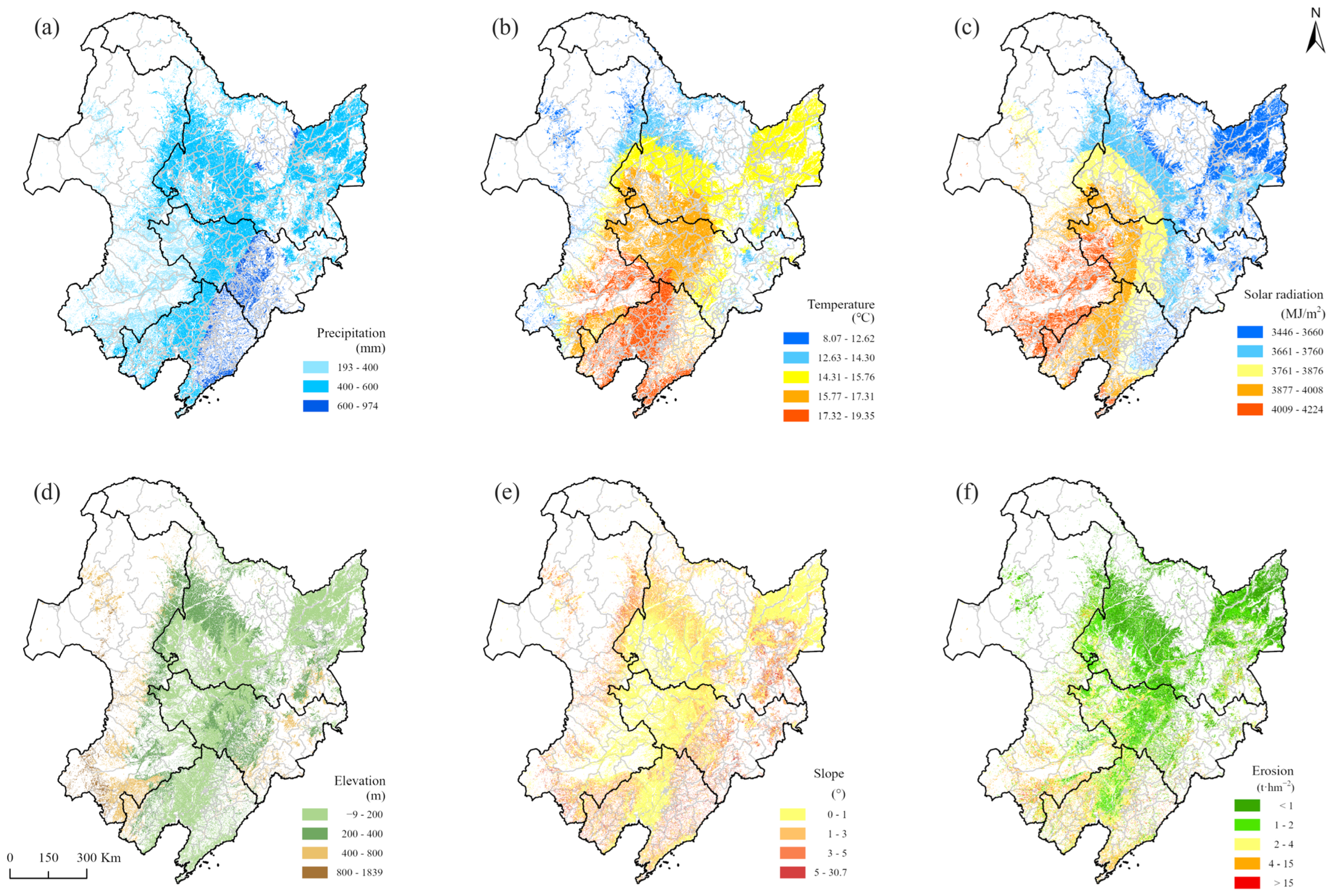

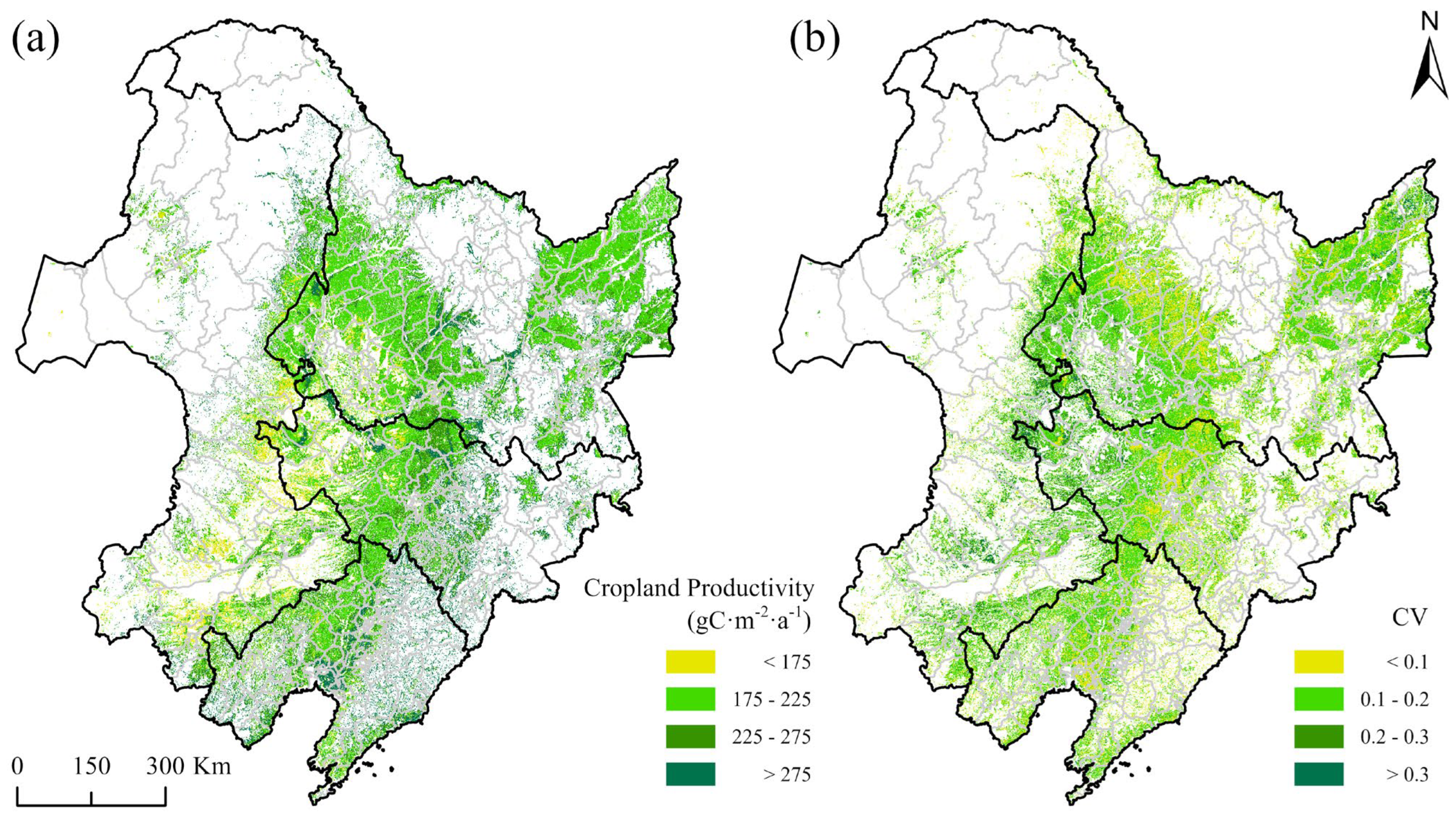

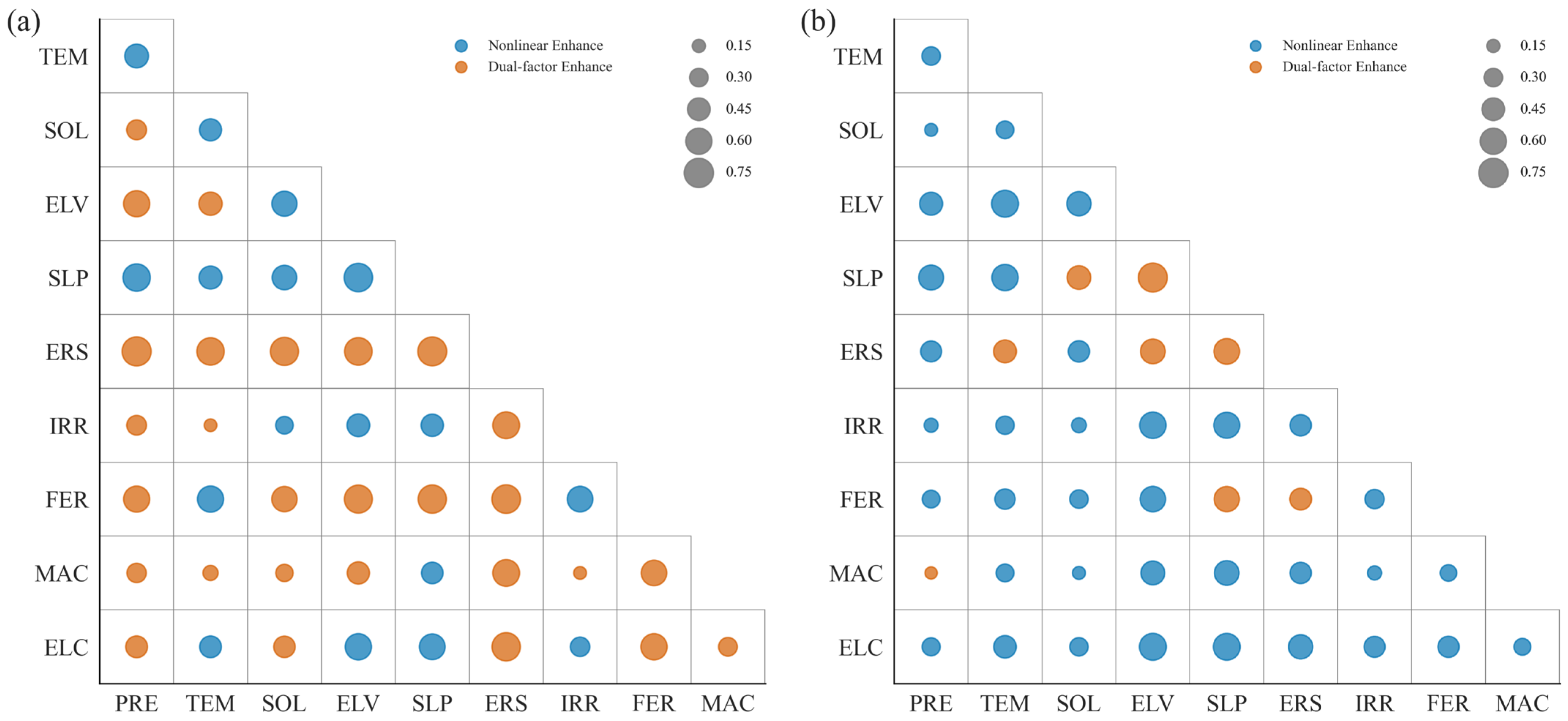
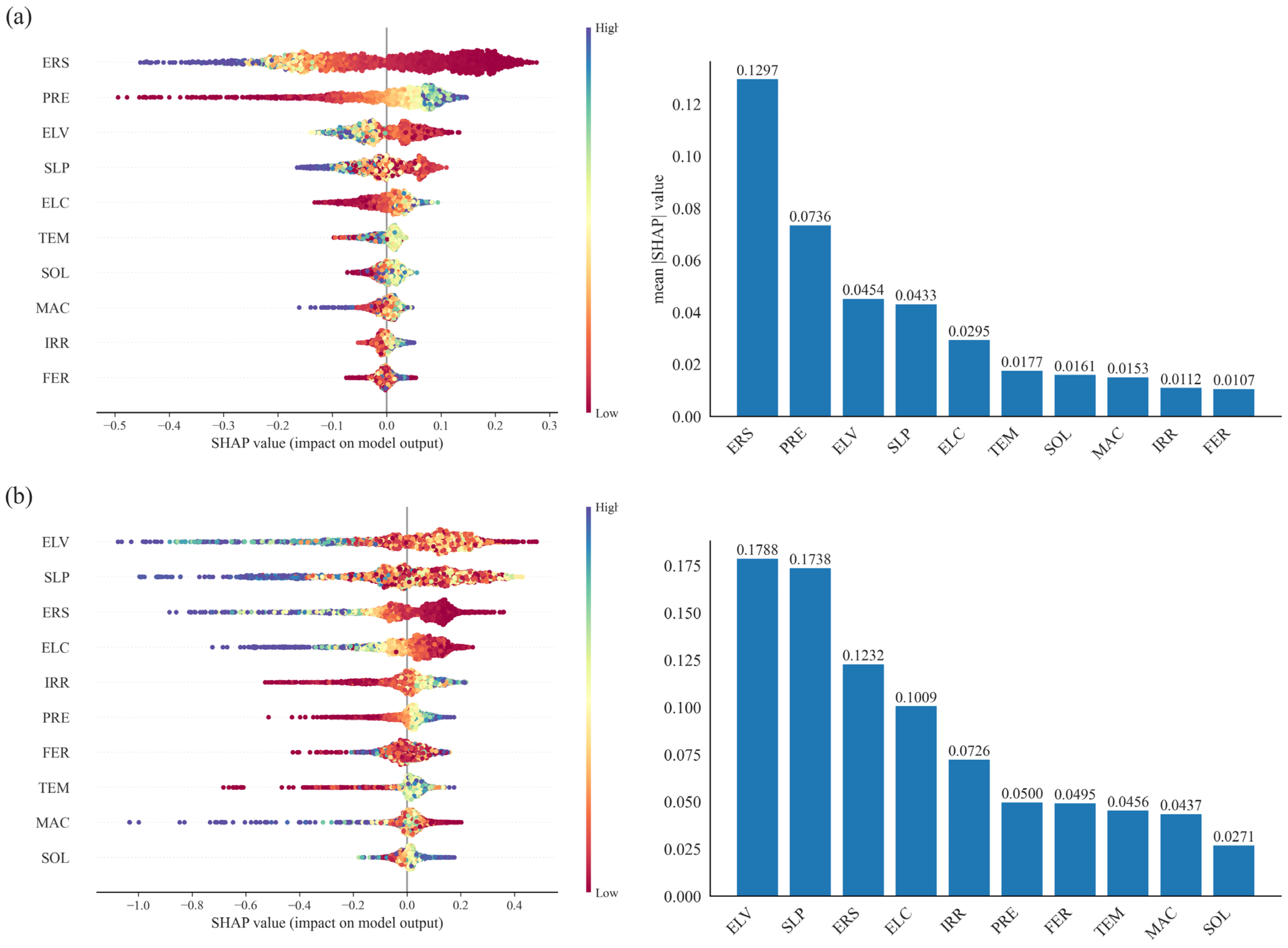
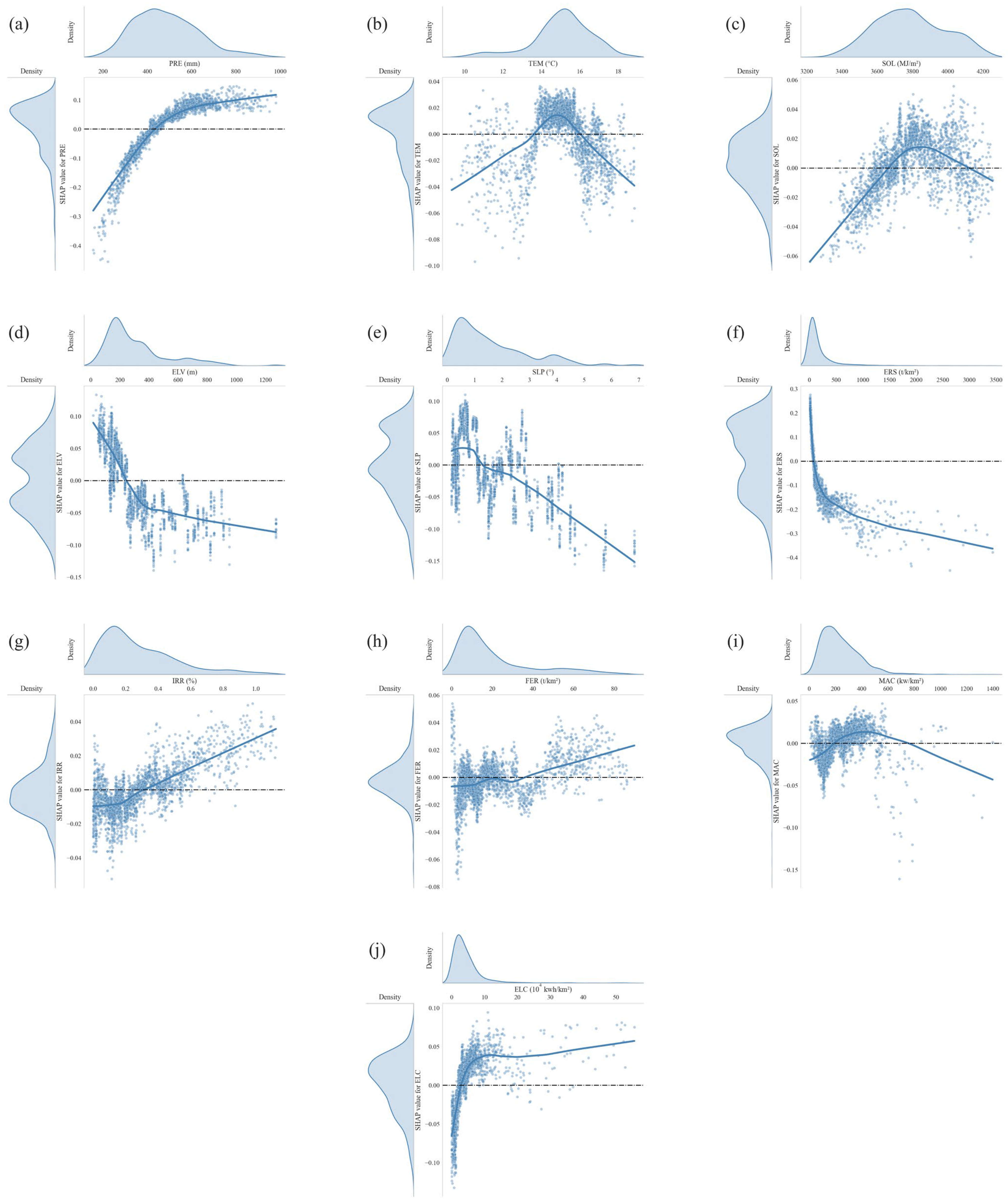
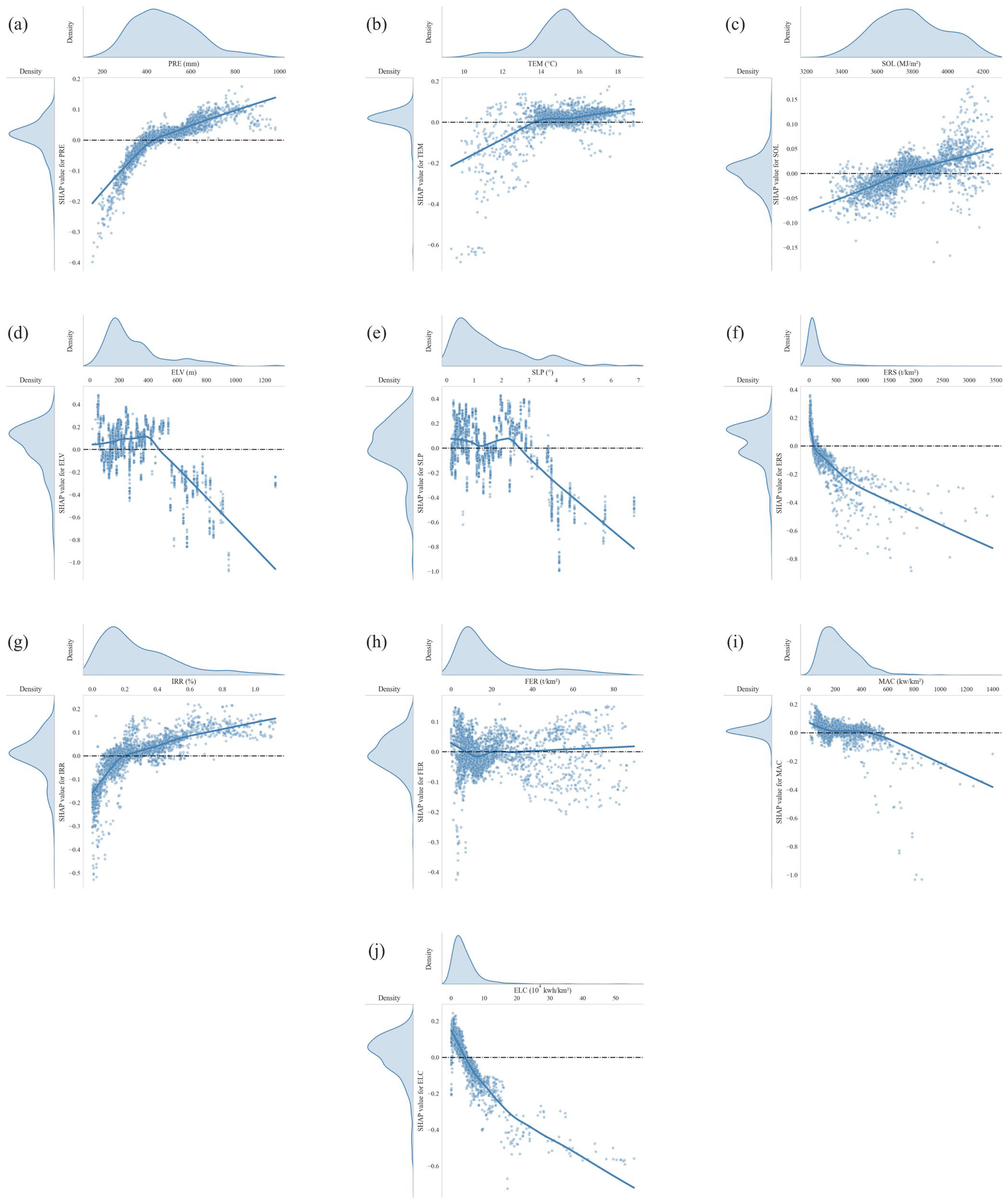
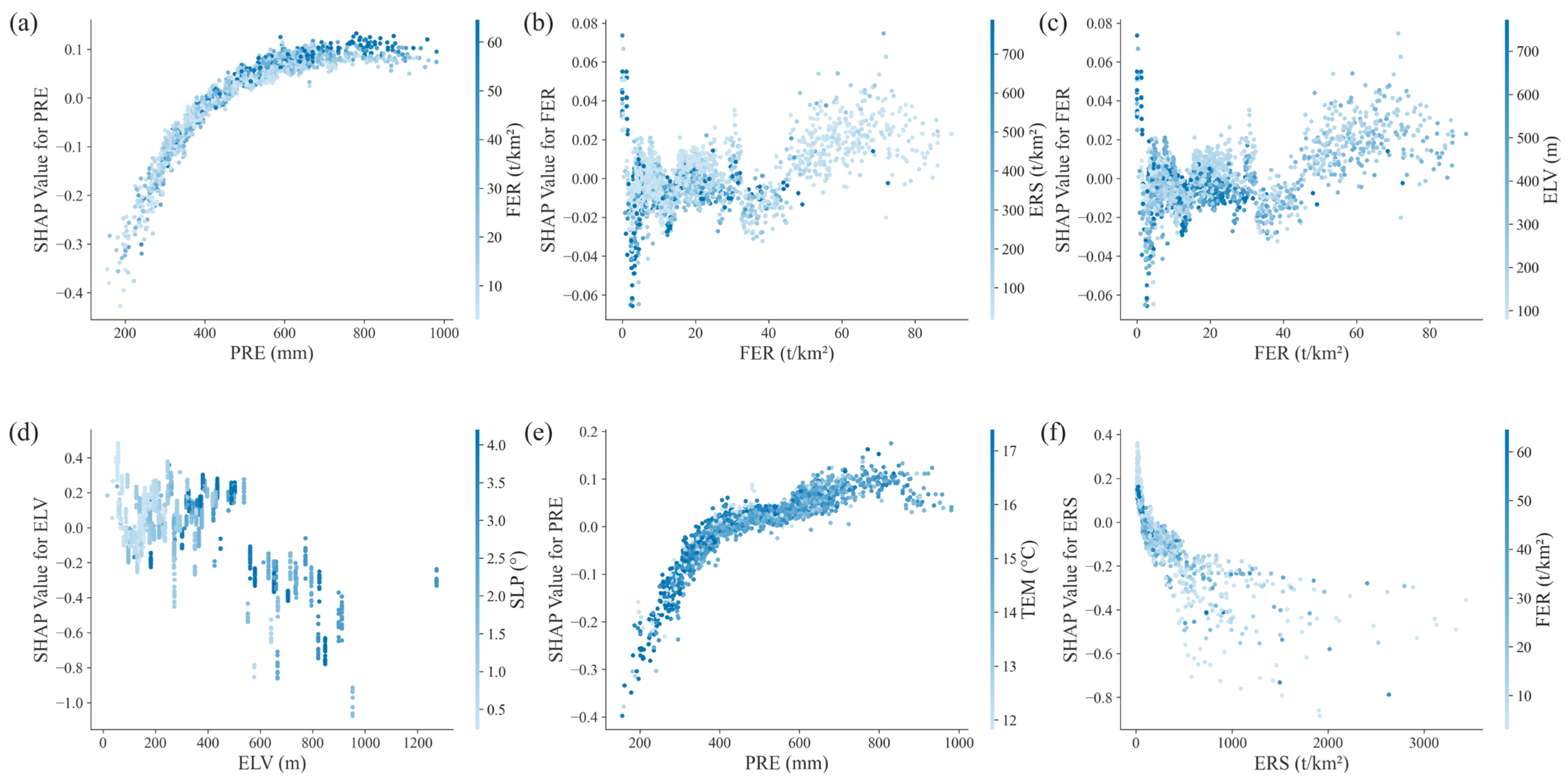
| Variable | Definition | Hypothesized Effects | Data Source | Key Reference |
|---|---|---|---|---|
| Response variables | ||||
| Average cropland productivity (ACP) | The average value of growing season cropland NPP (estimated by the CASA model) for each county | - | - | - |
| Total cropland productivity (TCP) | The total value of growing season cropland NPP (estimated by the CASA model) for each county | - | - | - |
| Explanatory variables | ||||
| Precipitation (PRE) | The sum of growing season-based cropland precipitation | Sufficient water availability is crucial for crop growth. Higher precipitation generally promotes productivity. | RESDC | [11,43] |
| Temperature (TEM) | The average temperature during the growing season on cropland | Appropriate temperature ranges support productivity. Extremely high or low temperatures can hinder physiological processes, shorten effective growing seasons, and reduce productivity. | RESDC | [11,43] |
| Solar radiation (SOL) | The total amount of solar radiation received during the growing season on cropland | Solar radiation is essential for photosynthesis. Adequate sunlight typically increases biomass accumulation, namely the NPP cropland productivity. | ERA-5 | [11] |
| Elevation (ELV) | The average elevation of cropland | Higher elevations usually have shorter growing seasons and thus limit the cropland productivity. | SRTMDEM v3.0 | [46] |
| Slope (SLP) | The average slope of cropland | Plains are more favorable for agriculture and are more productive. | SRTMDEM v3.0 | [46] |
| Erosion (ERS) | The intensity of wind and water erosion of cropland | Soil erosion threatens cropland productivity, especially in Northeast China. High erosion rates can lead to lower cropland quality and degraded soil health. | [45] | [7] |
| Effective irrigation (IRR) | The proportion of cropland covered with effective irrigation | Adequate irrigation satisfies water demands, stabilizing cropland productivity under variable rainfall patterns and reducing the risk of drought stress. | NBSC | [16,43] |
| Fertilizer application (FER) | The intensity of chemical fertilizer usage per unit of cropland | Proper fertilizer application improves soil fertility and provides essential nutrients, enhancing crop growth and resilience to less favorable conditions. Overuse, however, can lead to environmental degradation. | NBSC | [16,43] |
| Machinery (MAC) | The intensity of agricultural machinery power per unit of cropland | Enhanced mechanization typically increases cultivation efficiency and improves the timeliness of cropland operations, and therefore boosts cropland productivity. | NBSC | [47,48] |
| Electricity (ELC) | The intensity of electricity consumption in rural areas per unit of cropland | Sufficient electricity supply supports cropland operations. Improved access to electricity is linked to higher agricultural productivity. | NBSC | [47,48] |
| Interaction Types | Condition |
|---|---|
| Nonlinear attenuation | |
| Single-factor nonlinear attenuation | |
| Dual-factor enhance | |
| Independent | |
| Nonlinear enhance |
| Model Name | ACP | TCP | ||||
|---|---|---|---|---|---|---|
| R2 | MAE | RMSE | R2 | MAE | RMSE | |
| CatBoost | 0.933 | 0.065 | 0.085 | 0.961 | 0.109 | 0.151 |
| XGBoost | 0.918 | 0.069 | 0.094 | 0.968 | 0.095 | 0.135 |
| LightGBM | 0.919 | 0.071 | 0.094 | 0.950 | 0.121 | 0.170 |
| Random Forest | 0.915 | 0.072 | 0.096 | 0.942 | 0.109 | 0.184 |
| Support Vector Machine | 0.705 | 0.140 | 0.179 | 0.473 | 0.433 | 0.552 |
Disclaimer/Publisher’s Note: The statements, opinions and data contained in all publications are solely those of the individual author(s) and contributor(s) and not of MDPI and/or the editor(s). MDPI and/or the editor(s) disclaim responsibility for any injury to people or property resulting from any ideas, methods, instructions or products referred to in the content. |
© 2025 by the authors. Licensee MDPI, Basel, Switzerland. This article is an open access article distributed under the terms and conditions of the Creative Commons Attribution (CC BY) license (https://creativecommons.org/licenses/by/4.0/).
Share and Cite
Gao, R.; Cai, H.; Xu, X. Analysis of Driving Factors of Cropland Productivity in Northeast China Using OPGD-SHAP Framework. Land 2025, 14, 1010. https://doi.org/10.3390/land14051010
Gao R, Cai H, Xu X. Analysis of Driving Factors of Cropland Productivity in Northeast China Using OPGD-SHAP Framework. Land. 2025; 14(5):1010. https://doi.org/10.3390/land14051010
Chicago/Turabian StyleGao, Runzhao, Hongyan Cai, and Xinliang Xu. 2025. "Analysis of Driving Factors of Cropland Productivity in Northeast China Using OPGD-SHAP Framework" Land 14, no. 5: 1010. https://doi.org/10.3390/land14051010
APA StyleGao, R., Cai, H., & Xu, X. (2025). Analysis of Driving Factors of Cropland Productivity in Northeast China Using OPGD-SHAP Framework. Land, 14(5), 1010. https://doi.org/10.3390/land14051010







